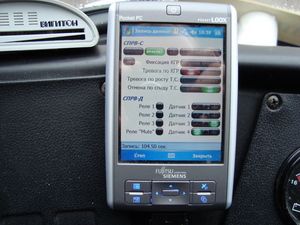Main Sector of relevance\IRC classification 5. Electronics, IT and Telecommunication
5.16 Board model of experimental system designed for monitoring of functional status of transport system operators “man-machine”
Developers’ contact information
State Scientific Institution “Joint Institute of Mechanical
Engineering of the National Academy of Sciences of Belarus”
12, Akademicheskaya Str., Minsk 220072
Tel/fax: +375 (17) 210-07-49; Web-site:
http://oim.by
Summary
It is known that “human factor” is one of the main reasons of failures, emergencies or disasters occurring in the “man-machine” systems. According to different estimates, “human factor” accounts for 50-92% of all cases of failures in different types of activities. Mistakes are made by operators controlling “man-machine” systems as well as by operators performing executive functions. The problem of elimination (minimization) of “human factor” negative influence on efficiency of “man-machine” systems presupposes a systematic approach and solving of the following interconnected tasks: creation of the optimal organizational structure of control; meeting ergonomic requirements related to the working places of operators; professional selection; training and retraining of supervisors using special training devices for acquiring skills of non-standard actions in upset conditions; diagnostics of functional status for some types of activity before the shift; organization of reasonable work and rest shifts; monitoring of functional status of operators in the very process of work.
Description
The general view of a board model of the experimental system
designed for monitoring of functional status of “man-machine” transport
system operators is presented on Fig. 1 and Fig. 2. The model on Fig.1 is based
on driver’s activity maintenance system (SPRV) and notebook MaxSelect Mission
A330, the model on Fig.2 – on the basis of PC Fujitsu-Siemens Pocket LOOX N/C
Series.
Driver’s activity maintenance system includes:
SPRV-N – the portable part of the system “Bracelet” and “Ring” used
for monitoring of electrodermatologic parameters of drivers, their
pre-processing, and transferring of present information by means of near
telemetry to the permanent subsystem.

Fig. 1. General view of board model of experimental system on the basis of notebook MaxSelect Mission A330

Fig. 2. – General view of board model of experimental system on the basis of PC Fujitsu-Siemens Pocket LOOX N/C Series
SPRV-S – receiver of signals from the portable part of the
system, controller of the system for final signal processing in accordance with
the relevant schemes and organization of biofeedback by means of indicator
placed on the front panel with button for the driver's approval of potential
capability to perform necessary algorithms of actions;
SPRV-D – a package of sensors and control relays for registration of the
performed algorithms and sending of controlling signals to the electrical
equipment of a transport vehicle.
The board model of the experimental system makes it possible to register and to
store 19 parameters characterising efficiency of execution of the following
algorithm of actions by transport system “man-machine” operator: 1 –
date; 2 – current record time; 3 – characteristics of signal sent from the
sensor SPRV-N “Bracelet”; 4 – characteristics of signal sent from the
sensor SPRV-N “Ring”; 5 – signal “alarm” related to tonic scale of
“Bracelet”; 6 – clearing the signal “alarm” related to the parameters
of “Bracelet”; 7 – signal of “alarm” related to phase scale of the
“Ring”; 11 – readings of display SPRV-S; 12 - sign of pushing the button
“RB” by the driver; 13 – input 1 (left turn); 14 – input 2 (brake pedal
work); 15 – input 3 (driver turns on the emergency lighting); 16 – input 4
(right turn); 17 – output 1 (automatic switching on of the emergency
lighting); 18 – 2 (automatic auto-signal switching on); 19 – output 3 (not
active, spare); 20 – output 4 (Mute relay, automatic turning down of
automobile radio).
Technology type
Technical advantages and economic benefits
The system makes it possible to investigate the dynamics of operators’ functional status changes in relation to performed algorithms or their parts, and to record the results. The system can be used for ergonomic investigations and studies in the sphere of engineering psychology in order to minimize negative aspects of “human factor” during engineering and operating of the “man-machine” transport systems of different purposes.
Technology differentiation and uniqueness
—
Context in which technology was identified
Under organizers’ invitation:
The scientific report “Increasing of drivers’ reliability on the basis of
status control automatization in the process of transport vehicle operation”
is made in the frame of the Belarusian Transport Congress, workshop “Problems
of safety ensuring during transportation of goods and passengers” (May 31,
2007) with demonstration of the system.
The invited scientific report “On increasing reliability of automobile
drivers” is made during the seminar “Enhancing of goods and passengers
safety while transportation” in the frame of the 3rd international
specialized exhibition “Man and safety” (June 11, 2008) with demonstration
of system.
Technological keywords
Transport systems “man-machine”, operator, driver, safety, human factor.
Development Stage
Intellectual property rights
Range of applications
“Man-machine” transport systems.
Classifier Used at the EU Innovation Relay Centres
Preferable Regions
Practical experience
The board model of the experimental system designed for monitoring of functional status of “man-machine” transport system operators is used by the Ministry of Transport and Communication of the Republic of Belarus for actual test of SPRV on long-distance passenger buses MAZ-152 and truck tractors MAZ 544069 320; it is used by the Joint Institute of Mechanical Engineering of the National Academy of Sciences of Belarus for functional tests of SPRV on the mine truck BelAZ-75473 and 75137 with MTU engines and for experimental study of dynamics of operators functional status changes in the very process of performing the algorithms.
Environmental impact
None.
Type of collaboration sought
Terms and restrictions
—
Available technical assistance